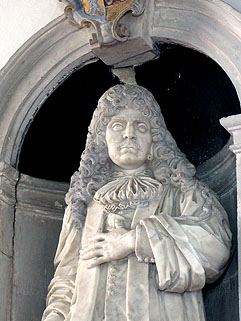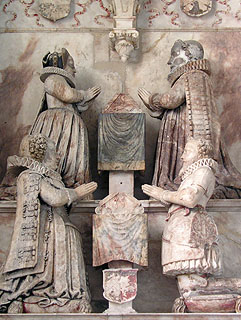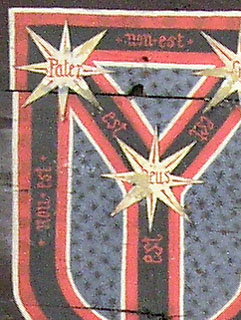'Seasons of mist and mellow fruitfulness...' - well, John, you evidently never came to Cambridgeshire in October. There was nothing soft about the day we visited Haslingfield. The sky was very pale blue, almost white, and the sun had no warmth in it. The wind cut straight to the bone. The fields were the colour of ivory, with dark shadows welling up below the surface of the soil, like shapes under the white skin of flint. Among the fields out there stand some of the University's radio telescopes, looking like thoughtful giants, staring forever up into the heavens. All in all, it was a powerful atmosphere, and I wasn't sure I liked it. The fens can be bleak, but so can the fields, and with the last straggling migrants wheeling above, it was quite oppressive.
Haslingfield, then, was a good place to be visiting. It's a nice village, big and bustling and very much alive. The church is rather like that, too. The first thing one notices is the great west tower. It's all built of stone, and is a particularly fine Perpendicular production - the first thing that points to the richness of the local gentry, perhaps. It has prominent corner turrets, which are square (and themselves are buttressed for most of their height) until the parapet, where they become octagonal and end in little battlemented caps. The effect is very similar to Great St Mary's in Cambridge or Saffron Walden over in Essex, but in both those places the towers are more slender. Here in Haslingfield it is still tall, but stout. There is a fine base course of quatrefoils, along with the usual ornate Perpendicular west doorway.
More unusually, in the second stage of the tower there is a round air-hole, complete with tracery of its own - something I've never seen in a Cambridgeshire church before. Above that, the paired bell-openings are equally ornate. The guidebook says that the tower was restored in 1898, but is quiet on which features are original and which were inserted by the Victorians. Certainly, the presence of Northamptonshire bell-openings and a Norfolk air-hole make me suspicious, but Pevsner (backed up by the Royal Commission) insists that it's original. I tend to agree; the tower does share similarities with contemporaries in the area, and the tracery in the air-hole looks like it has been weathered by many more October winds than any Victorian insertion would yet have endured. Whatever period it is, it's very fine; one of the best in the county, I think, although I am always partial to grand Perpendicular.
Walking around the rest of the exterior, I was struck by how big the church is. It's wide, and long, though it also seems surprisingly low. It has two porches. The south is the nicer of the two, looking a little like an upturned boat with its round roof. It isn't used now, though, and entry to the church is through the north porch. We were greeted by a leering devil in a little roundel of glass on one side, and a charming teddy perched in some tracery on the other.
You step down quite a bit to get into the nave itself, hence the fact that the church looks rather low from outside. It's a very big interior, and the rather mean seating is dwarfed by the space, making it look empty. It is also a bit battered looking - the whitewash is grubby in places, and the tower arch has been filled in (a pity, because as one would imagine from the outside, it's quite a grand one). The clerestory is very nice, though - the windows are placed directly over the pillars, which is an unusual arrangement.
The roof in the nave is nothing to shout about, but those in the aisles are still painted, and they are very beautiful. There's also a fair amount of medieval glass surviving in the tops of the windows - all jumbled, of course, but there are still some nice images, including more of those leering devil heads. I wondered at first whether the tulip pulpit was medieval, but the guidebook disabused me: only the stone octagonal stem is medieval; the pulpit itself and the staircase leading to it were constructed from bits of a triple-decker which was dismantled during the Victorian restoration. I feel a bit sad about that - I like triple decker pulpits - but the replacement does look very nice.
The chancel is guarded by a squat little iron fence - painted red and rather municipal-looking. The rood screen survived until the Victorian restoration, but was deemed too derelict to be worth saving, and so it went. This is a pity, but don't dwell on it too long. The chancel itself is full of treasures.
The first thing one notices is the fine set of tombs. These are the Wendy family, of Haslingfield Manor. The most famous Wendy was Dr Thomas, Royal Physician to Henry VIII, Mary I and Elizabeth I. He died in 1560, and was buried here, though his tomb was removed by the restorers. Goodness knows why. Some of his descendents remain, including his nephew Sir Thomas Wendy, who was MP for Cambridgeshire and presumably entertained Elizabeth herself when she stayed at Haslingfield in 1564. He died in 1612 and now kneels opposite his wife, and is accompanied by his son Sir William and his wife. There is also a monument to a Sir Thomas Wendy (d. 1673) in the form of a statue in a niche, staring sadly down on the scene.
With all these monuments to look at, it took us a while to notice the most remarkable thing in this church. Looking up, we discovered that the ceiling of the chancel is painted with an extraordinary collection of symbols. Initially we thought this had to be survival from before the Reformation, since some of the symbols - hearts with crowns of thorns, paired keys, shields of the Trinity and instruments of the passion - were extremely Catholic looking. The guidebook to the church states, however, that the ceiling was painted by the Wendy family in the early 17th century. The symbols in fact represent a church calendar, taken from something called the 'Clog Almanack', a popular calendar of high days and holy days used in the Middle Ages by peasants to remind them of their devotional calendar.
Somewhat inconsistently, the guide goes on to say that the symbols are those for the Red Letter Days in the Book of Common Prayer. This baffled me. The symbols I'd mistaken for instruments of the passion were in fact St Bartholomew's sticks and things like that, but would the 17th century church really have encouraged people to celebrate the feast of the Annunciation and the Visitation, for example? It's all very fishy. To add to the confusion, Pevsner and the RCHM say that the ceiling was repainted in the 19th century, though there's a lot of evidence that it was faithful to a 17th century original. Whatever the meaning of all these symbols, the ceiling is a very interesting and unusual survival, and rather pretty in its way - I was very struck with the Lamb and Banner over the high altar.
All Saints' was open when we visited





